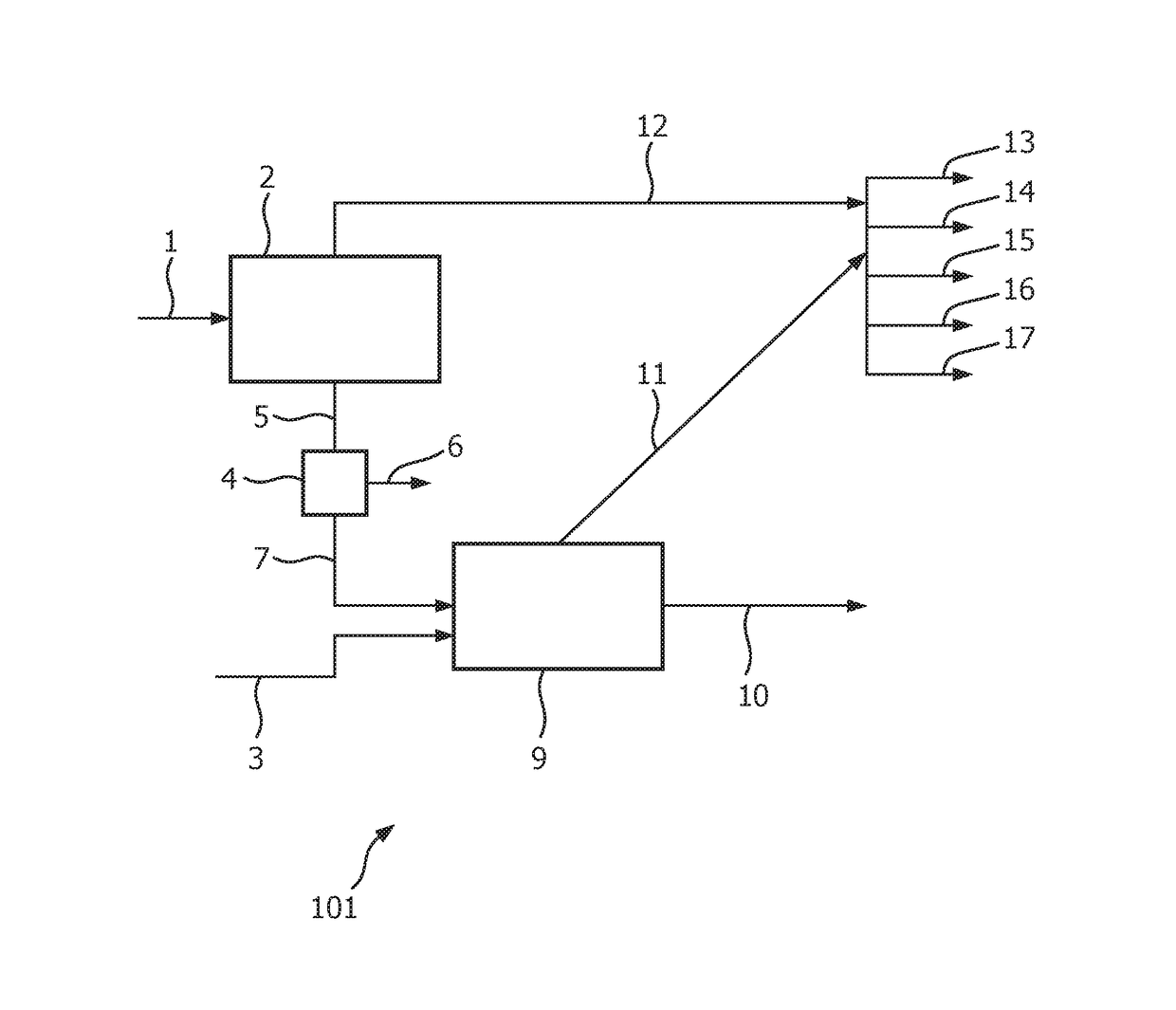Process for converting mixed waste plastic (MWP) into valuable petrochemicals
a technology of petrochemicals and mixed waste, which is applied in the direction of hydrocarbon oil treatment, thermal non-catalytic cracking, liquid hydrocarbon mixture production, etc., can solve the problems of no large-scale plant that operates directly, no large-scale plant exists today that operates directly, and waste plastic disposal into landfills is becoming increasingly difficult. , to achieve the effect of enhancing the hydrogen content of the mixed feed and stable feed to the hydrocracker
- Summary
- Abstract
- Description
- Claims
- Application Information
AI Technical Summary
Benefits of technology
Problems solved by technology
Method used
Image
Examples
example 1
[0049]An in-situ fluidized bed lab tubular reactor having a length of 783 mm and an inner diameter of 15 mm was used. The reactor was housed in a split-zone 3-zone tubular furnace with independent temperature control for each zone. The size of each zone was 9.3 inches (236.2 mm). The overall heated length of the reactor placed inside the furnace was 591 mm. The reactor wall temperature was measured at the centre of each zone and was used to control the heating of each furnace zone. The reactor had a conical bottom and the reactor bed temperature was measured using a thermocouple housed inside a thermowell and placed inside the reactor at the top of the conical bottom. Also, the reactor wall temperature was measured at the conical bottom to ensure that the bottom of the reactor was hot. The reactor bottom was placed at the middle of the furnace bottom zone for minimizing the effect of furnace end cap heat losses and maintaining the reactor bottom wall temperature within a difference ...
example 2
[0053]The Saturates, aromatics, resins and asphaltenes (SARA) analysis of the 340+ deg C. residue (AHAR) from Arab heavy crude oil is 53.7 / 34.8 / 3.1 / 8.1. The SARA analysis for plastic pyrolysis oil (PPoil) boiling below 240 deg C. is 24.6 / 75.4 / 0 / 0. The combination of these streams in different weight proportions is analysed in the below table along with predicted stable asphaltenes concentration in these mixtures.
[0054]
70% AHAR +50% AHAR +25% AHAR +100% AHAR30% PPOil50% PPoil75% PPoil100% PPoilAsphaltenes8.15.74.12.00.0Saturates53.745.039.231.924.6Aromatics34.847.055.165.275.4Resins3.12.21.60.80.0Predicted stable4.66.37.48.810.2Asphalteneconcentration inmixture fromaromatics andresinsconcentration inmixture
[0055]As can be seen from the table, stable asphaltenes combinations can be obtained in the mixture of AHAR with PPoil in all proportions exceeding at or above 30 wt % of PPoil in the mixture.
example 3
[0056]50.39 kg of the pyrolysis oil produced by pyrolysis of 100 Kg of mixed plastics as given in example 1 is mixed with 200 Kg of Arab light AR and fed to a hydrocracking unit operating at 394 deg C. and 186 Kg / cm2 g. The yield is as below:
[0057]
ProductYield, KgH2Methane + ethane4.9Propane8.1Butane17.0ethylene0propylene0Butenes01,3-butadiene0carbondioxide0Carbonmonoxide0C5-150 deg C.93.2H2S4.5NH30.2150-288 deg C.87.1288-343 deg C.30.6343+ deg C.4.9
PUM
| Property | Measurement | Unit |
|---|---|---|
| temperature | aaaaa | aaaaa |
| wt % | aaaaa | aaaaa |
| wt % | aaaaa | aaaaa |
Abstract
Description
Claims
Application Information
 Login to View More
Login to View More - R&D
- Intellectual Property
- Life Sciences
- Materials
- Tech Scout
- Unparalleled Data Quality
- Higher Quality Content
- 60% Fewer Hallucinations
Browse by: Latest US Patents, China's latest patents, Technical Efficacy Thesaurus, Application Domain, Technology Topic, Popular Technical Reports.
© 2025 PatSnap. All rights reserved.Legal|Privacy policy|Modern Slavery Act Transparency Statement|Sitemap|About US| Contact US: help@patsnap.com

